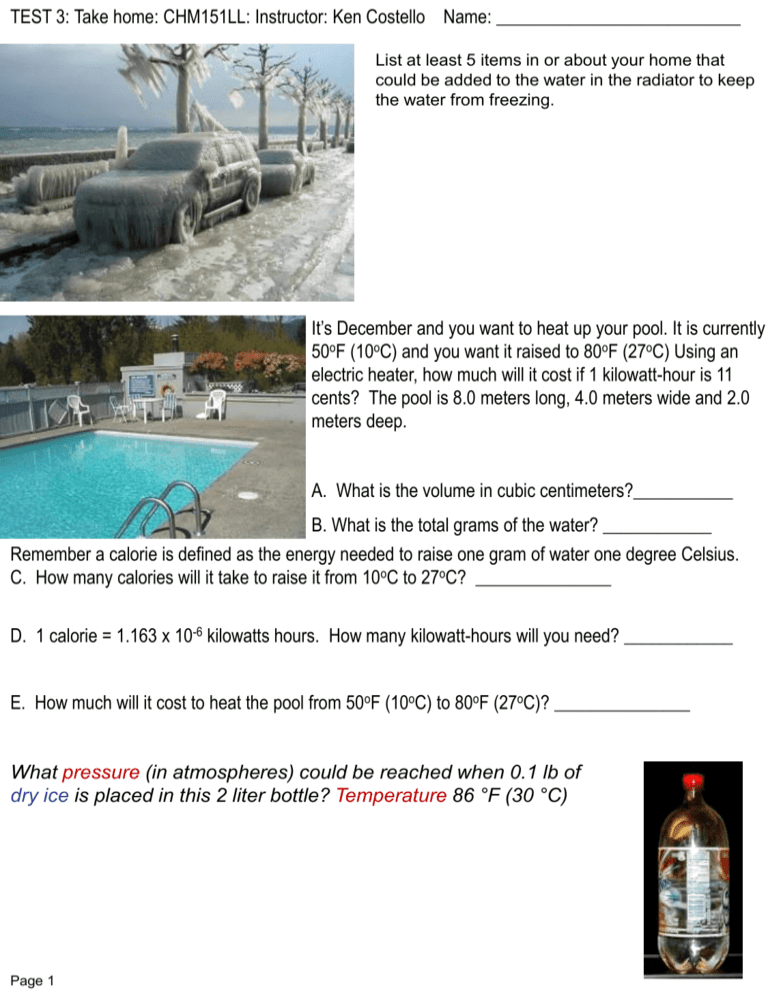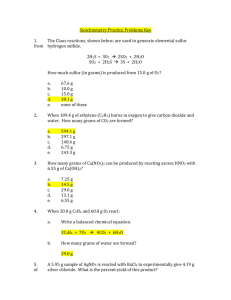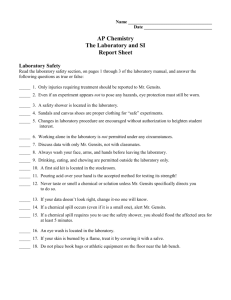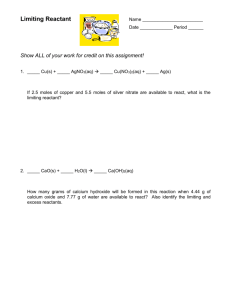could be reached when 0.1 lb of dry ice is placed
advertisement

TEST 3: Take home: CHM151LL: Instructor: Ken Costello Name: ___________________________ List at least 5 items in or about your home that could be added to the water in the radiator to keep the water from freezing. It’s December and you want to heat up your pool. It is currently 50oF (10oC) and you want it raised to 80oF (27oC) Using an electric heater, how much will it cost if 1 kilowatt-hour is 11 cents? The pool is 8.0 meters long, 4.0 meters wide and 2.0 meters deep. A. What is the volume in cubic centimeters?___________ B. What is the total grams of the water? ____________ Remember a calorie is defined as the energy needed to raise one gram of water one degree Celsius. C. How many calories will it take to raise it from 10oC to 27oC? _______________ D. 1 calorie = 1.163 x 10-6 kilowatts hours. How many kilowatt-hours will you need? ____________ E. How much will it cost to heat the pool from 50oF (10oC) to 80oF (27oC)? _______________ What pressure (in atmospheres) could be reached when 0.1 lb of dry ice is placed in this 2 liter bottle? Temperature 86 °F (30 °C) Page 1 There’s a night club in Philadelphia called “Chemistry” The décor inside follows a chemistry theme. Naturally, college students who take chemistry make up a good fraction of the patrons. Two got in an argument about which has more calories, a 12 fl. oz. bottle of beer or a vodka martini containing a shot of 100 proof vodka. They both agreed that the martini is basically just ethanol. The label on the beer said 5% alcohol (v/v) with 6.6 grams of carbohydrates, 2.2 grams of protein, and 0.0 grams fat. They knew that both carbohydrates and proteins produce 4 kcal per gram. Fat is 9 kcal but no fat was there. They didn’t know the kcal per mL or kcal per gram of ethanol. If they found the calories of ethanol given per gram, they would need to know the density (g/mL) of ethanol. They also had to convert 12 fl.oz. and 1 shot to milliliters. A friend had a Palm Pilot with Internet connection, so they got the data and figured out which drink had the most calories. They calculated that 1 shot of 100 proof vodka had about 160 kilocalories, which was more than what they figured for the beer. Show your calculations here or on a separate sheet to verify or refute their result. Page 2 Chemistry Teacher Goes Berserk after Accident A chemistry experiment gone awry caused many students to think their teacher had gone crazy. During a pyrotechnic demonstration, a bag of sulfur sitting nearby was also ignited. The room filled with smoke and then the sprinkler system went off. The students started to scream that their faces were burning as if the sprinkler was spraying acid on them instead of water. The instructor grabbed several of the erasers from the chalkboard and started smacking students’ faces with the erasers. Students were shocked and some yelled, “Our teacher has gone crazy!” Others were pleading, “Please don’t hit me!” Students who had been hit by an eraser looked hideous because their faces were now bubbling. Some looked like ghosts with all the white chalk on their faces. The teacher kept yelling “Kill some carb and hate, kill some carb and hate.” At least that’s what it sounded like over all the screaming. Then one student yelled “The pain is gone! I’m not going to die!” and started to laugh in relief. Students looked her way, but the sight of her foaming face laughing seemed even more diabolical than the teacher was acting. A few seconds later others who had been struck with the eraser started saying the same thing, “The burning sensation and pain is going away!” Everyone started to realize that the chalk from the erasers was neutralizing the acid. In an about-face the students who hadn’t yet been hit started rushing towards the teacher and begged him to hit them with the erasers. Later, students commented that they knew the teacher was real tough and didn’t like whiners, so they thought he was hitting them because they were complaining. They also knew he had been on an Atkins diet, and thought a mental breakdown had him yelling about killing and hating carbs. After things calmed down, the students remembered that burning sulfur is the cause of acid rain. Sulfur and oxygen makes sulfur dioxide and sulfur trioxide. When these come in contact with the water (sprinkler water in this case), the gases form sulfurous acid and sulfuric acid. Chalk is mostly calcium carbonate, which neutralizes acid (it’s similar to baking soda). When they heard his say “calcium carbonate,” it sounded like “kill some carb and hate.” One reason they jumped to that conclusion was the teacher’s favorite dieting advice was “kill the carbs.” He’d also say that since his initials were “K.C.” it was easy to remember that slogan. Show all work on separate sheet: A. Write a balanced reaction for sulfur dioxide + water becoming sulfurous acid. B. Write a balance reaction for sulfur trioxide + water becoming sulfuric acid. C. Write a balance reaction for sulfuric acid being neutralized by calcium carbonate all the way to CO 2 and H2O. C. If the water from the sprinklers had a pH of zero, what is the molar concentration (moles/liter) of the acid (H +)? D. If the water had a pH of 0.5, what is the molar concentration of acid? E. Let’s say on the face was 25 mL of water at pH of 1.0 and 0.30 grams of chalk (CaCO 3) was transferred to the face. Is that enough to neutralize all of the acid? Page 3 Tragedy Engulfs Lake Nyos In the African nation of Cameroon 1,000 villagers live around the beautiful Lake Nyos. The lake sits in the cauldron of an ancient volcano. The date is August 21, 1986. That night Ephriam Che was in his house on a cliff above Lake Nyos. Around 9 P.M., Che heard a rumbling that sounded like a rockslide. Then a strange white mist rose from the lake. He went to bed, feeling ill. At first light, Che headed downhill. Nyos, normally crystal blue, had turned a dull red. When he reached the base of the cliff, the normal chorus of songbirds and insects was absent. Then he saw dead livestock. Frightened, he ran on downhill to the village. There, nearly every one of the village's 1,000 residents was dead, including his parents, siblings, uncles and aunts. "I was crying, crying, crying," he says. It was the end of the world, or so he believed. All told, some 1,800 people perished around Lake Nyos. For months no one knew the cause of this catastrophe. Nothing toxic was detected. Then a volcanologist took a deep water sample and as he brought it to the surface, the lid of the sample bottle blew off. The water was loaded with carbon dioxide. The water near the bottom of the lake was carbonated water. It was concluded that a small earthquake or rock slide triggered the release of CO2. Being heavier than air, the CO2 filled up the crater and suffocated the villagers. Some of the CO2 flowed downhill and killed another 800 people in the lower areas. To make the lake safe from CO2 eruptions, a pipe was run from the deepest water layer to the surface, releasing the gas to disperse harmlessly in the air. The pipe shoots carbonated water into the air like a natural geyser. However, one pipe may not be enough. Show all calculations on separate sheet: What is the density of CO2 at 30°C (86°F) in milligrams/Liter? If air has the density of 1.64 mg/L at 30°C, how many times more dense is CO2 compared to air? A warning system could be made to identify CO2 by pumping air samples into a chamber and taking readings of pressure, temperature, and volume; plus weighing the sample. Chamber is 4.0 liters, pressure is 3.1 atmospheres, weight is 22 grams, and the temperature is 30°C (86°F). What molar mass would be calculated and does that indicate CO2? Page 4






